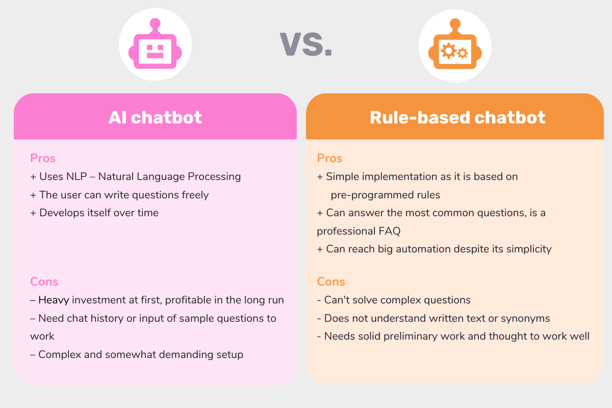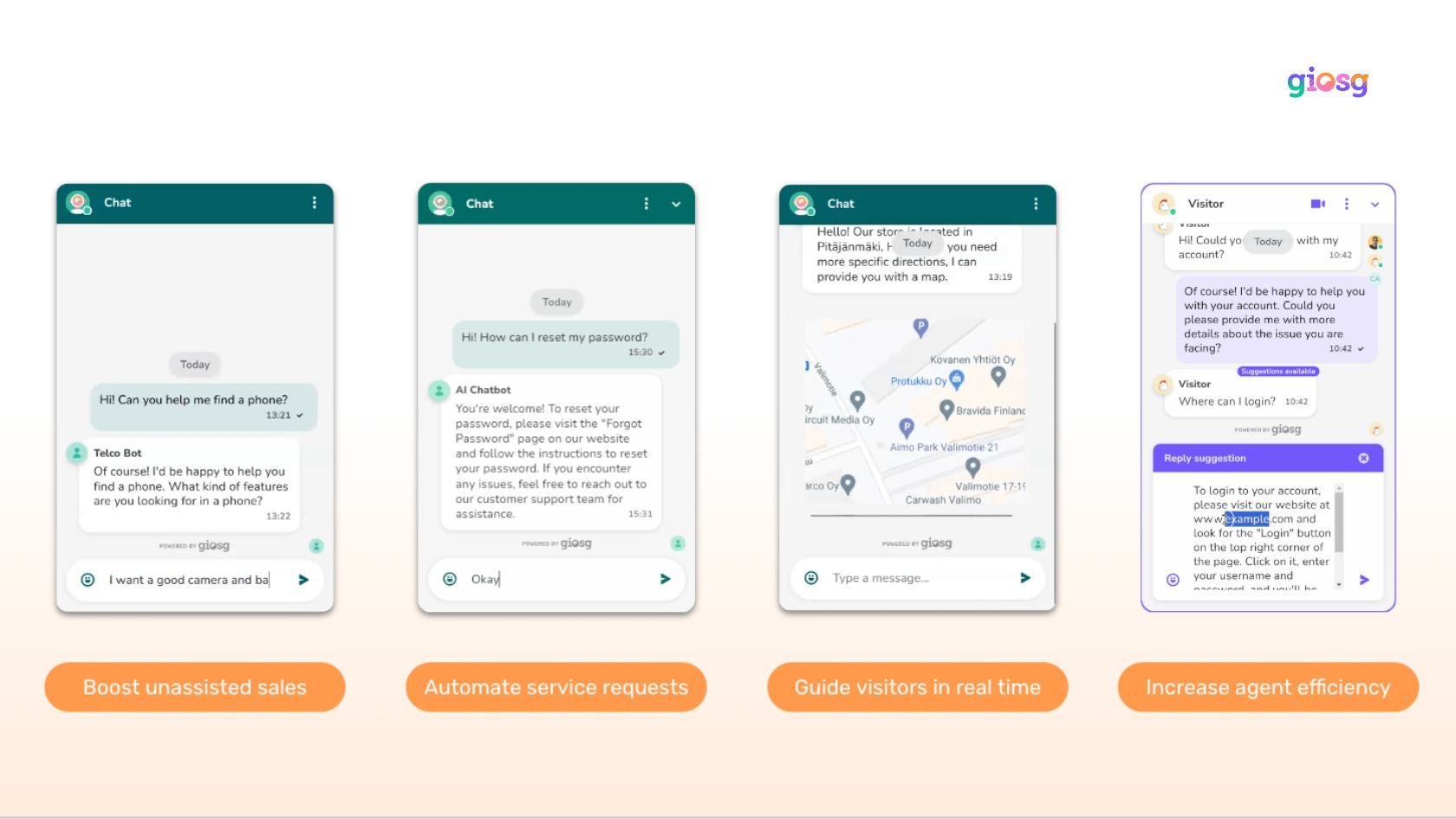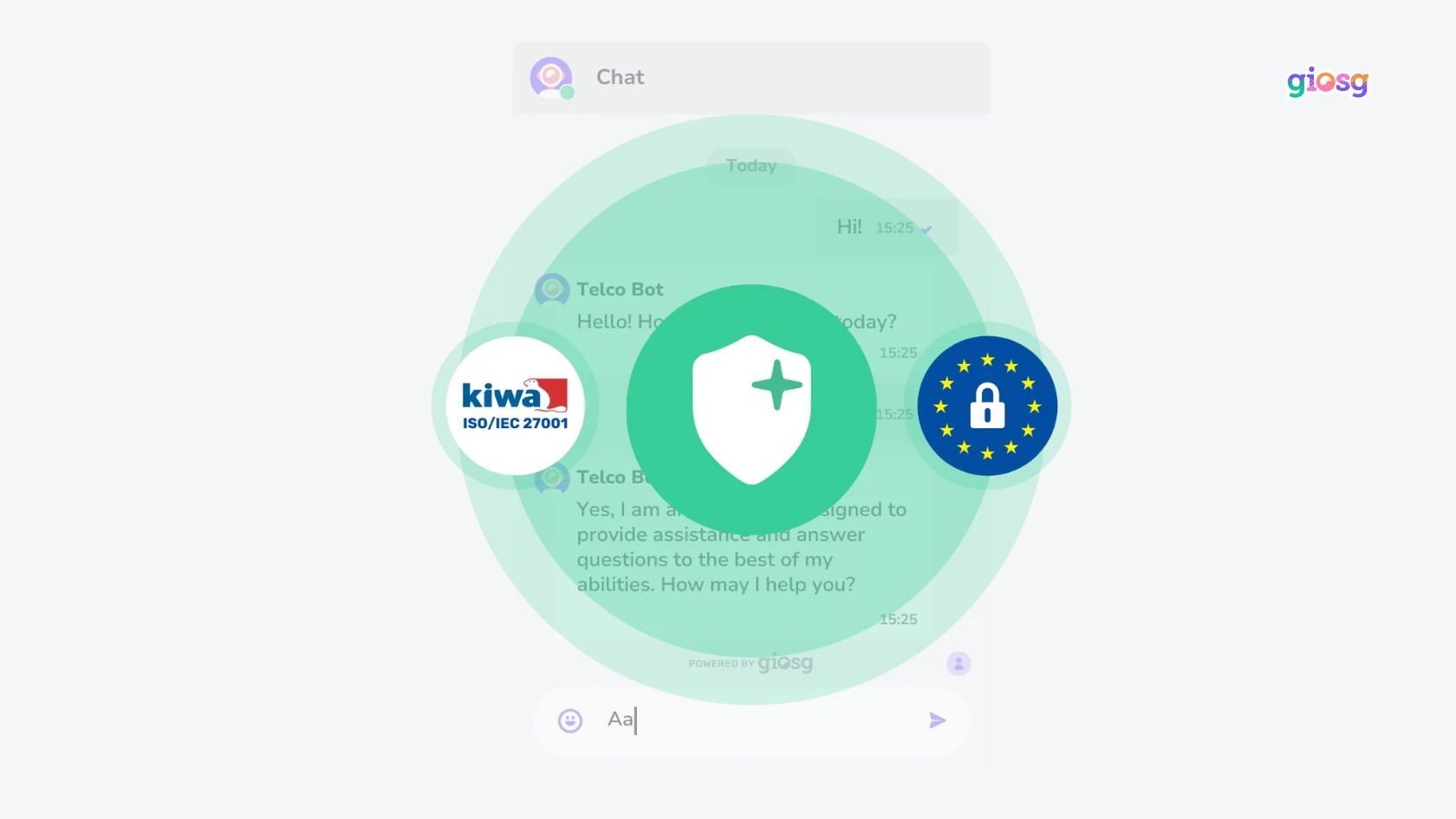.jpg?width=975&height=488&name=blog%20preview%20image%20(4).jpg)
The "AI revolution" is shaking things up more than the name suggests. From cooking up new data to coming up with solutions we haven't even thought of yet.
At the heart of all this is something called generative artificial intelligence (AI).
Understanding what this trend is about and how it can be used in your industry is a must.
That's why we're here – your one-stop shop for all things generative AI.
We got our giosg AI expert, Petri Savolainen, to answer all the questions you may have about generative AI. Let's get into it 👇
|
Table of contents |
|
|
|
|
|
|
|
What is generative AI?
Generative AI is a type of artificial intelligence (AI) technology that is designed to create new content, data, or other outputs that mimic human creativity or behaviour.
.jpg?width=612&height=344&name=Generative%20AI%20Blog%20visuals%20(1).jpg)
Unlike traditional AI systems that solve specific tasks or problems based on existing rules or training data, generative AI can create entirely new outputs by itself.
How does generative AI work?
Generative AI works by using deep learning models to generate new data that is similar to the training data they have been exposed to before.
The generative AI deep learning models are trained on large datasets.
These models, which we'll explore more below, learn the underlying patterns and structures in the data, which allows them to generate new outcomes.
What is a prompt in generative AI?
A prompt is an input given to the model to generate a specific output based on the learned data.
In simple terms, it’s the instruction you give the generative AI model to get your desired output. Depending on the model, this looks slightly different.
For text-based models like GPT, prompts could be questions, statements, or even a single word. For image-generating models, prompts might describe the desired image in detail.
What is the difference between generative AI and ChatGPT?
Generative AI is a broad category of artificial intelligence that includes different models and techniques. It can generate new content, data, or other outputs (text, images, music, etc.) that are similar to existing data.
ChatGPT, on the other hand, is a specific case of generative AI, specifically developed for conversational interactions with users.
ChatGPT is based on OpenAI's GPT (Generative Pre-trained Transformer) architecture and is trained on a diverse range of text from the internet. It's great at understanding and producing human-like text responses based on the context of a conversation.
What about conversational vs generative AI?
.jpg?width=1680&height=945&name=Generative%20AI%20Blog%20visuals%20(3).jpg)
Conversational AI, like chatbots and virtual assistants, interact with humans in a very natural and intuitive way, often through text or voice.
Generative AI, on the other hand, has a broader use range beyond just conversation. Instead, it focuses on creating new content. This can be text, images, videos, or music.
While conversational AI can be seen as a subset of generative AI when it generates text responses in conversations, generative AI does a lot more.
Both are powered by advances in AI and machine learning, but they have very distinct purposes and different goals.
Is generative AI a form of machine learning?
Yes, generative AI is a form of machine learning. It focuses on generating new data similar to the training data.
Are chatbots generative AI?
Yes, chatbots can be considered a form of generative AI when they generate responses to user inputs.
However, there are also rule-based chatbots, that are not considered generative AI.
Instead of using AI, they select responses from a predetermined list based on specific rules or a decision tree, without generating new content. Rule-based chatbots are simpler and more efficient for straightforward tasks or cases where responses do not require variation or deep understanding.

Applications of generative AI
Many industries are bringing generative AI into their strategies and recognizing its potential.
And even for those who have not yet jumped on the bandwagon – there's a clear consensus:
virtually every sector has something to benefit from using generative AI.
Next, let’s look at some of the practical generative AI applications for businesses.
Benefits of generative AI for businesses
So how does generative AI help businesses?
Simply put, generative AI can be used in endless ways. Just to name a few, it has been helping businesses with:
- content creation
- personalized experiences
- product design
- process optimization
- virtual assistants and customer service
- predictive analytics
- risk management
- language translation
So by this point, whatever task or process you can think of, there's most likely a use case for it.
Generative AI use cases
Want to see examples of how this can look like in your industry?
Let's have a look at some of the industry-specific use cases below.
Generative AI in retail
Retailers often struggle to deliver personalized shopping experiences, manage inventory, and predict inconsistent product demand.
By analyzing customer data in real time, generative AI allows retail businesses to provide scalable, personalized product recommendations, marketing, and shopping experiences for millions of customers.

A great example of this is the Amazon recommendation engine
When you shop on Amazon, the platform suggests products based on your browsing and purchase history, items in your shopping cart, and what other customers have viewed or purchased.
You most likely have seen "Frequently bought together," "Customers who bought this item also bought," and "Recommended for you" sections.
This has many benefits to the shopper but it also helps Amazon to optimize inventory levels based on demand.
Generative AI in telecom
For telcos, the online store is an essential channel for customer acquisition, support and sales.
Generative AI technologies, such as personalized chatbots and other AI-driven recommendation tools, are already a key practice for leading telcos to engage with their customers online.
.jpg?width=612&height=344&name=Generative%20AI%20Blog%20visuals%20(8).jpg)
"In this sector, automation is crucial.
By analyzing customer data and interaction patterns, AI can offer personalized plan options and special promotions tailored to individual needs and preferences."
Petri continues to highlight:
.jpg?width=1584&height=396&name=Quote%20Banner%20(4).jpg)
AI chatbots can handle a variety of customer queries in real time, from product information to troubleshooting. All while using your existing team and speeding up the resolution process.
This level of web personalization improves the customer shopping experience, leading to higher engagement, satisfaction, and sales conversions.
Lastly, another area where AI has been particularly helpful in this industry is tagging customer cases at scale. This helps get insight into what the contact cases are about and thereby improves decision-making quality.
Generative AI in automotive
AI in the automotive sector has changed how dealerships and brands engage potential customers.
.jpg?width=1680&height=945&name=Generative%20AI%20Blog%20visuals%20(9).jpg)
AI-driven chatbots and virtual assistants have become increasingly popular amongst the leading automotive companies to instantly capture and qualify leads 24/7, without human intervention.
These AI tools:
- engage users visiting automotive websites
- ask personalized questions based on user interaction
- assess visitor needs and buying intent
It has done wonders in improving the digital customer experience by providing quick responses and allowing precise segmentation of leads based on their preferences and likelihood to purchase.
This is a sure way to increase efficiency while making your sales teams happy. They can prioritize high-intent leads, optimizing their efforts and significantly increasing conversion rates!
Generative AI for enterprises
For enterprises worldwide, automating routine and repetitive tasks and providing consistent, high-quality customer service across channels remains a challenge.
Especially in scaling operations efficiently and their resources.
It also plays an important role in decision-making processes and customer service.
AI-powered chatbots and virtual assistants offer round-the-clock customer service, handling inquiries and providing support with an unheard level of efficiency. And the applications don't end there.
We have put together a list of the 4 most effective enterprise chatbot use cases for you to try!
.png?width=2240&height=1260&name=Blog%20visuals%20(87).png)
What generative AI tools are available for businesses?
Some key generative AI tools for businesses are:
- GPT-3
- DALL-E
- various AI-driven content recommendation and optimization platforms
- advanced AI chatbots
- AI copilots
Many businesses already use one or multiple of these to enhance productivity, creativity, and customer engagement. Some of the most popular uses at the moment are:
AI chatbots that use GPT-3, developed by OpenAI, are widely used for automating customer service responses and generating content.
AI-driven platforms for content recommendation that you can often see across e-commerce and streaming services, personalize user experiences by generating suggestions based on user behaviour and preferences.
About OpenAI
Whenever you hear talk about AI, OpenAI is a word that often pops up.
OpenAI is the San Francisco-based company behind the infamous tool ChatGPT.
Is Microsoft Azure OpenAI the same as just OpenAI?
Not really.
MS Azure OpenAI services provide access to a separate copy of OpenAI's chatGPT service that is operated by Microsoft, not by OpenAI.
While both provide a version of chatGPT, each also provides other, different AI-related services.
Does Microsoft (Azure OpenAI) get my chat conversations if I use AI-generated replies?
Each time a reply is generated by chatGPT, it reads chat session contents to understand the context and generates a new reply using the latest message so yes.
But the chat content is only kept for the duration of generating a reply, not longer.
Risks & Ethical considerations
What are the risks or limitations of using generative AI for businesses?
Some of the risks and concerns that you should be aware of are:
❌ Data privacy concerns
❌ Potential for generating biased or inaccurate content
❌ and reliance on high-quality data for effective training
While AI solutions offer transformative benefits, we also suggest that you always manage the potential risks.
There are things you can do to reduce the risks. For example:
✅ Continuous training and updating of AI models
✅ Pick tools with clear privacy and compliance measures
Ensuring that all customer interactions are secure and meet regulatory standards. This is particularly important for making sure your audience is as open to the technology as you are.
Remember, they most likely have the same or even more concerns as you.
So make sure you’re ready to soothe their worries and reassure them when it comes to the tech you’re implementing.
What are companies' most common mistakes when implementing generative AI tools, and how to avoid them?
A few of the most common mistakes we’ve seen companies make when implementing AI tools are:
1. Lack of clear strategy
Some companies often jump into generative AI without a strategic approach, leading to misaligned objectives and wasted resources.
Before you get started with AI tools, map out where it fits in your strategy and what you wish to get out of it. There are also many resources out there that help you efficiently set up your tools.
.jpg?width=1680&height=945&name=Generative%20AI%20Blog%20visuals%20(6).jpg)
2. Insufficient training data
Another common pitfall is underestimating the need for ongoing training of AI models to adapt to new customer service scenarios. This affects the quality and fairness of the outputs you’re getting.
3. Neglecting user feedback
Ignoring user feedback on AI-generated content can miss valuable insights for improvement. This also includes the design of the AI interactions.
Are they user-friendly and intuitive? These are crucial for gaining customers' acceptance.
So always make sure you’re aware of how your audience is feeling about these advancements. One way to do this is to actively listen to user feedback, whether it is through regular surveys or NPS score tracking.
4. Overlooking ethical and legal implications
You need to consider the ethical and legal aspects of using generative AI to avoid potential issues related to copyright, privacy, and bias.

Luckily, there are many tools out there, like giosg, that offer highly secure solutions that are widely accepted and used across industries like banking and healthcare.
Overall, avoiding these mistakes means careful planning, ethical consideration, user-centred design, and a focus on continuous improvement.
Future of generative AI
There’s a lot still to come with generative AI. But a lot of it is still unknown.
Let’s look at what we can say about the future for now.
What's next?
.jpg?width=1680&height=945&name=Generative%20AI%20Blog%20visuals%20(5).jpg)
Source: McKinsey, State of AI in 2023
In the future, we expect to see even more advanced content creation, deeper integration into creative methods, and expanding applications in decision-making and problem-solving across all industries.
We can already see it moving towards creating even more sophisticated and nuanced content, like high-quality videos, interactive media, and realistic simulations.
Its integration into different processes will also become more seamless.
Tools like AI copilots that enhance creativity rather than replace it, will become more widely used.
giosg AI 🤖
We at giosg offer a range of AI tools for self-service interactions and chat automation for the most efficient AI-powered live chat service.
AI Copilot
AI Copilot offers AI-generated reply suggestions to chat agents for a moderated AI experience.
The giosg AI Copilot works by suggesting GPT-powered answers to Live Chat agents for unmatched service efficiency and customer satisfaction.
Imagine this:
Before: Agents type replies manually relying only on their personal information and language proficiency.
After: Agents use automatically generated, in-context replies that are based on trained information and are always available in native-level language.
AI Copilot is a great first AI solution to adopt until the GPT-powered answers are fully trusted and proven to work. After that, you might want to consider a GPT-powered AI Chatbot for full automation.
AI Chatbot
AI Chatbot communicates directly with your customers in fully personalized, relevant, and actionable conversations powered by generative AI and giosg interactions.
You can even have your chatbot find out what your customers are looking for and recommend relevant products.
Plus, our AI Chatbot can be deeply integrated with your system, fully tailored to your brand, and it can provide interactive, fully actionable replies beyond text for the most efficient customer experiences. Overall, AI chatbot is equipped with:
- Personalized, AI-generated replies
- Actionable replies beyond text
- Multisource & integrated knowledge bases
- Unique AI Personas to enable multiple use cases
AI Translations
With our new AI translation feature your chat automatically translates visitor messages into the agent's language and vice versa, eliminating language barriers and the need for external tools.
AI chat translations ensure:
- Multilingual support
Seamlessly extend customer service across languages, simplifying market expansion into new regions. - Faster responses & real-time interactions
Agents can instantly understand and respond to inquiries in their native language, ensuring quick and seamless interactions. - Enhanced efficiency & scalability
Maintain consistent communication regardless of customer language. - Improved customer satisfaction
By providing support in customers' preferred language, they feel more valued and understood, leading to more happy and loyal customers.
Now, you can ensure exceptional customer experiences and personalized service in any language!
What language models does giosg use?
Giosg uses several freely available or proprietary language-specific models optimized for matching visitor inquiries with knowledge base content.
We then use chatGPT provided by MS Azure OpenAI services to synthesize replies from the matches.
Do you have more questions about giosg AI? If you'd like to learn more and get all of your questions answered, feel free to contact one of our AI experts! 😊